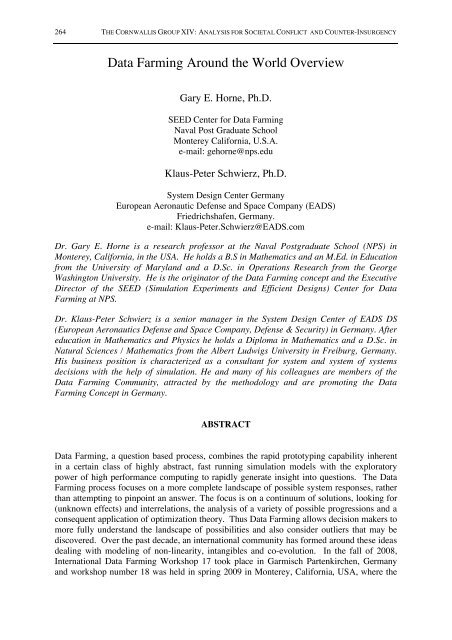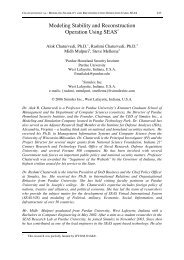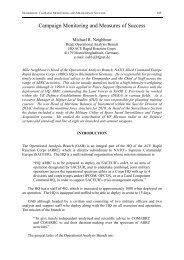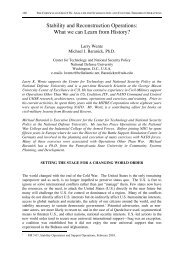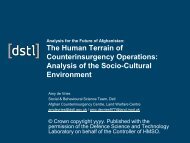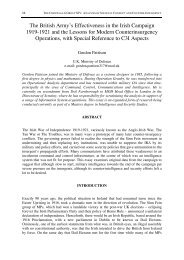Data Farming Around the World Overview - Cornwallis Group
Data Farming Around the World Overview - Cornwallis Group
Data Farming Around the World Overview - Cornwallis Group
- No tags were found...
You also want an ePaper? Increase the reach of your titles
YUMPU automatically turns print PDFs into web optimized ePapers that Google loves.
264 THE CORNWALLIS GROUP XIV: ANALYSIS FOR SOCIETAL CONFLICT AND COUNTER-INSURGENCY<strong>Data</strong> <strong>Farming</strong> <strong>Around</strong> <strong>the</strong> <strong>World</strong> <strong>Overview</strong>Gary E. Horne, Ph.D.SEED Center for <strong>Data</strong> <strong>Farming</strong>Naval Post Graduate SchoolMonterey California, U.S.A.e-mail: gehorne@nps.eduKlaus-Peter Schwierz, Ph.D.System Design Center GermanyEuropean Aeronautic Defense and Space Company (EADS)Friedrichshafen, Germany.e-mail: Klaus-Peter.Schwierz@EADS.comDr. Gary E. Horne is a research professor at <strong>the</strong> Naval Postgraduate School (NPS) inMonterey, California, in <strong>the</strong> USA. He holds a B.S in Ma<strong>the</strong>matics and an M.Ed. in Educationfrom <strong>the</strong> University of Maryland and a D.Sc. in Operations Research from <strong>the</strong> GeorgeWashington University. He is <strong>the</strong> originator of <strong>the</strong> <strong>Data</strong> <strong>Farming</strong> concept and <strong>the</strong> ExecutiveDirector of <strong>the</strong> SEED (Simulation Experiments and Efficient Designs) Center for <strong>Data</strong><strong>Farming</strong> at NPS.Dr. Klaus-Peter Schwierz is a senior manager in <strong>the</strong> System Design Center of EADS DS(European Aeronautics Defense and Space Company, Defense & Security) in Germany. Aftereducation in Ma<strong>the</strong>matics and Physics he holds a Diploma in Ma<strong>the</strong>matics and a D.Sc. inNatural Sciences / Ma<strong>the</strong>matics from <strong>the</strong> Albert Ludwigs University in Freiburg, Germany.His business position is characterized as a consultant for system and system of systemsdecisions with <strong>the</strong> help of simulation. He and many of his colleagues are members of <strong>the</strong><strong>Data</strong> <strong>Farming</strong> Community, attracted by <strong>the</strong> methodology and are promoting <strong>the</strong> <strong>Data</strong><strong>Farming</strong> Concept in Germany.ABSTRACT<strong>Data</strong> <strong>Farming</strong>, a question based process, combines <strong>the</strong> rapid prototyping capability inherentin a certain class of highly abstract, fast running simulation models with <strong>the</strong> exploratorypower of high performance computing to rapidly generate insight into questions. The <strong>Data</strong><strong>Farming</strong> process focuses on a more complete landscape of possible system responses, ra<strong>the</strong>rthan attempting to pinpoint an answer. The focus is on a continuum of solutions, looking for(unknown effects) and interrelations, <strong>the</strong> analysis of a variety of possible progressions and aconsequent application of optimization <strong>the</strong>ory. Thus <strong>Data</strong> <strong>Farming</strong> allows decision makers tomore fully understand <strong>the</strong> landscape of possibilities and also consider outliers that may bediscovered. Over <strong>the</strong> past decade, an international community has formed around <strong>the</strong>se ideasdealing with modeling of non-linearity, intangibles and co-evolution. In <strong>the</strong> fall of 2008,International <strong>Data</strong> <strong>Farming</strong> Workshop 17 took place in Garmisch Partenkirchen, Germanyand workshop number 18 was held in spring 2009 in Monterey, California, USA, where <strong>the</strong>
266 THE CORNWALLIS GROUP XIV: ANALYSIS FOR SOCIETAL CONFLICT AND COUNTER-INSURGENCYof possibilities. The term distillation is added, because <strong>the</strong> intent is to distill <strong>the</strong> question athand and down into as simple a representation as possible. Also, models used in ProjectAlbert were specifically developed and used because <strong>the</strong> capability to rapidly prototypescenarios is also very important in this process.Although Project Albert was a US-sponsored effort, it had a strong spirit of internationalcollaboration which made a great deal of cooperative effort among researchers around <strong>the</strong>world possible. For example, <strong>the</strong> three models mentioned in <strong>the</strong> paragraph above weresponsored by MoD´s in New Zealand, Germany, and <strong>the</strong> US respectively. Due to <strong>the</strong> fact,that Project Albert was question-based also allowed practitioners from around <strong>the</strong> world torally around <strong>the</strong> developing <strong>Data</strong> <strong>Farming</strong> methodologies because of <strong>the</strong> impact it had upon<strong>the</strong>ir present shared application interests.Because many of <strong>the</strong> questions of interest have wide applicability, <strong>the</strong> work teams atinternational workshops typically consist of representatives from minimum three andsometimes up to six different countries and <strong>the</strong> workshops overall have usually consisted ofabout 8 to 12 teams ending in more than 120 applications of <strong>the</strong> models to specific missionrelated questions. The first international workshop was organized in 1999 and 12 workshopswere held under <strong>the</strong> auspices of Project Albert which ended in September 2006. Since thattime <strong>the</strong> international <strong>Data</strong> <strong>Farming</strong> community has continued cooperative efforts and <strong>the</strong>most recent workshops, <strong>the</strong> 17 th and 18 th workshops were held in fall 2008 and in spring2009. Our presentation here will highlight <strong>the</strong>se most recent workshops, but details on <strong>the</strong>o<strong>the</strong>r workshops and o<strong>the</strong>r <strong>Data</strong> <strong>Farming</strong> efforts can be found at http://harvest.nps.edu, <strong>the</strong>website of <strong>the</strong> SEED (Simulation Experiments and Efficient Designs) Center for <strong>Data</strong><strong>Farming</strong> at <strong>the</strong> United States Naval Postgraduate School.DATA FARMINGOVERVIEW<strong>Data</strong> <strong>Farming</strong> combines efficient experiment design, <strong>the</strong> rapid prototyping of agent-baseddistillations with <strong>the</strong> exploratory power of high performance computing to rapidly generateinsight into military questions. <strong>Data</strong> <strong>Farming</strong> focuses on a more complete landscape ofpossible system responses and progressions, ra<strong>the</strong>r than attempting to pinpoint an answer.This “big picture” solution landscape is an invaluable aid to <strong>the</strong> decision maker in light of <strong>the</strong>complex nature of <strong>the</strong> modern battle space. And while <strong>the</strong>re is no such thing as an optimaldecision in a system where <strong>the</strong> enemy has a role, <strong>Data</strong> <strong>Farming</strong> allows <strong>the</strong> decision maker tomore fully understand <strong>the</strong> landscape of possibilities and <strong>the</strong>reby make more informeddecisions. <strong>Data</strong> <strong>Farming</strong> also allows for <strong>the</strong> discovery of outliers that may lead to findingsthat allow decision makers to no longer be surprised by surprise.The simulations that defense analysts use are often large and complex. An evaluation ofcomplete landscapes is extremely time consuming, sometimes not even possible. Also, even<strong>the</strong> smaller more abstract agent-based distillations referred to above can have manyparameters that are potentially significant and that could take on many values. And responsesurfaces can be highly non-linear. Thus, even with high performance computing and <strong>the</strong>small models used in <strong>Data</strong> <strong>Farming</strong>, gridded designs, where every value is simulated, areunwieldy.
HORNE AND SCHWIERZ: DATA FARMING AROUND THE WORLD OVERVIEW 267Thus, <strong>the</strong> statistical approach, using efficient experimental designs is essential and workin this area has been performed at <strong>the</strong> Naval Postgraduate School (NPS) in Monterey,California and NPS researchers have collaborated with o<strong>the</strong>rs worldwide as well (seeKleijman, Sanchez, Lucas, and Cioppa, 2005). <strong>Data</strong> <strong>Farming</strong> continues to evolve from initialProject Albert efforts (Hoffman and Horne, 1998) to <strong>the</strong> work documented in <strong>the</strong> latestedition of <strong>the</strong> Scy<strong>the</strong> (Horne and Meyer, 2009). This proceedings and bulletin of <strong>the</strong>International <strong>Data</strong> <strong>Farming</strong> Community contains <strong>the</strong> proceedings of <strong>the</strong> International <strong>Data</strong><strong>Farming</strong> Workshops that have taken place since Project Albert ended and is put out by <strong>the</strong>SEED Center for <strong>Data</strong> <strong>Farming</strong> at NPS.QUESTION-BASEDOver <strong>the</strong> past few years several articles have captured <strong>the</strong> fundamentals of <strong>Data</strong> <strong>Farming</strong> (e.g.Horne and Meyer, 2005 and Lawler, 2005), but <strong>the</strong> key is <strong>the</strong> question basis. Over <strong>the</strong> pastdecade and as we shall present in <strong>the</strong> next section, over 120 international work teams haveformed around questions at International <strong>Data</strong> <strong>Farming</strong> Workshops. On <strong>the</strong> o<strong>the</strong>r hand, at <strong>the</strong>Naval Postgraduate School over 60 <strong>the</strong>ses, many by international students, have beencompleted which have used data farming.These types of questions can never have precisely defined initial conditions and acomplete set of algorithms that describe <strong>the</strong> system being considered. These questionsaddress open systems that defy prediction. <strong>Data</strong> <strong>Farming</strong> is used to provide insight that canbe used by decision-makers. To accomplish this challenging task, <strong>Data</strong> <strong>Farming</strong> relies upontwo basic ideas:1. Use high performance computing (HPC) to execute models many times overvaried initial conditions to gain understanding of <strong>the</strong> possible outliers, trends,and distribution of results, and2. Develop models, called distillations, that are focused to specifically address<strong>the</strong> question.The discovery of surprises (both positive and negative) and potential options are madepossible by <strong>Data</strong> <strong>Farming</strong>, by providing <strong>the</strong> ability to process large parameter spaces.ITERATIVE PROCESS<strong>Data</strong> <strong>Farming</strong> is a collaborative and iterative team process (Horne and Meyer 2004b). Figure1 describes <strong>the</strong> <strong>Data</strong> <strong>Farming</strong> process as a set of imbedded loops of iteration. This processnormally requires input and participation by subject matter experts, modelers, analysts, anddecision-makers.The “Scenario Building” loop shown on <strong>the</strong> left side of <strong>the</strong> Figure involves developingand honing a model that adequately represents <strong>the</strong> system that addresses <strong>the</strong> question beingasked by <strong>the</strong> decision-maker. This is an iterative process that often requires honing <strong>the</strong>question as well.
268 THE CORNWALLIS GROUP XIV: ANALYSIS FOR SOCIETAL CONFLICT AND COUNTER-INSURGENCYFigure 1: <strong>Data</strong> <strong>Farming</strong> is an Iterative Process.The “Scenario Run Space Execution” loop shown in Figure 1 is entered once <strong>the</strong> basecase of <strong>the</strong> scenario is complete. In this loop <strong>the</strong> team defines an experiment whichdetermines which scenario input parameters should be examined and what processes shouldbe used to vary <strong>the</strong>m. Here <strong>the</strong> team is exploring <strong>the</strong> possible variations (or excursions of <strong>the</strong>base case) in <strong>the</strong> initial conditions of <strong>the</strong> scenario. Specifically those parameters that address<strong>the</strong> question being posed are considered.The defined experiment is used to guide <strong>the</strong> execution of many runs of <strong>the</strong> model in <strong>the</strong>HPC environment. Each run produces output which is collected by <strong>the</strong> <strong>Data</strong> <strong>Farming</strong> systemand provided as output to analysis capabilities. After analysis of <strong>the</strong> results, <strong>the</strong> team (or analgorithm) may decide to adjust or produce a new study or adjust <strong>the</strong> model to moreadequately address <strong>the</strong> question. This process continues until insight related to <strong>the</strong> decisionmaker’squestion has been gained.WORLD WIDE PARTNERSThe first international workshop took place in 1999. The first 4 workshops were methodologydriven, dealing with Complex Adaptive Systems Modeling and <strong>the</strong> agent basedrepresentation, with Statistical Experiment Design and Experiment Evaluation. Thesubsequent 14 workshops were application driven, contributions to <strong>the</strong> overall advancementof <strong>Data</strong> <strong>Farming</strong> takes place in <strong>the</strong> development of simulation models, scenarios within <strong>the</strong>models, and computer clusters to run <strong>the</strong> models audacious numbers of times. The real workis in making progress on important questions and <strong>the</strong> real secret is <strong>the</strong> combination ofmilitary subject matter experts and highly knowledgeable and multi-disciplinary scientists.This special mix of personnel has been <strong>the</strong> hallmark of <strong>the</strong> international workshops. It hasbeen a dynamic combination to have <strong>Data</strong> <strong>Farming</strong> work teams headed up by a person whoreally knows and cares about <strong>the</strong> question (e.g. a military officer who knows that <strong>the</strong> answersmay have an impact on both mission success and lowering casualties) and supported by menand women with technical prowess who can leverage <strong>the</strong> tools available. The international
HORNE AND SCHWIERZ: DATA FARMING AROUND THE WORLD OVERVIEW 269community forming around <strong>the</strong> ideas of <strong>Data</strong> <strong>Farming</strong> is shown in Figure 2. The workshopstook place in following cities: Kihei, Auckland, Cairns, Überlingen, Monterey, Quantico,Singapore, Wellington, Stockholm, Honolulu, Boppard, Den Hague, and GarmischPartenkirchen.Figure 2: The International <strong>Data</strong> <strong>Farming</strong> Community.Now we will now provide some details regarding how German involvement increasedfrom <strong>the</strong> participation in <strong>the</strong> early workshops when <strong>the</strong> methodologies were in <strong>the</strong> beginningstages of development. After Project Albert started <strong>the</strong> emphasis on using <strong>Data</strong> <strong>Farming</strong>tools within combat situations and <strong>the</strong> simulation tools were developed to represent <strong>the</strong>sesituations, <strong>the</strong> German Delegation carried in questions regarding peace support operations.Human factors modeling and <strong>the</strong> influences of intangibles are becoming more and moreessential in this question area. To simulate <strong>the</strong> non-attrition based parts in peace supportoperations <strong>the</strong> model PAX (after <strong>the</strong> Roman goddess of peace) was developed in Germanyand released to <strong>the</strong> International <strong>Data</strong> <strong>Farming</strong> Community. The contributions led to a broadacceptance of <strong>Data</strong> <strong>Farming</strong> in <strong>the</strong> German modeling and simulation community.All German applications had <strong>the</strong> clear goal: Not to replace <strong>the</strong> classical Modeling andSimulation tools by new ones but to apply both methods in an “operational syn<strong>the</strong>sis” (seeBrandstein, 1999). The application of complex adaptive systems <strong>the</strong>ory with <strong>the</strong> modelingfollowing <strong>the</strong> agent based paradigm had <strong>the</strong> goal to explore <strong>the</strong> wide field of non linearity, ofco-evolution and intangibles. Results were a continuum of solutions in <strong>the</strong> sense ofoptimization <strong>the</strong>ory with <strong>the</strong> relevant tools for a statistical experimental design and <strong>the</strong> semiautomatedevaluation techniques directing <strong>the</strong> user to unknown effects, or “surprises” andinterrelations in <strong>the</strong> analysis of a variety of possible progressions. Figures 3 and 4 show acomparison of “What we did” and “What we got” as German delegations by joining <strong>the</strong> <strong>Data</strong><strong>Farming</strong> Community.
270 THE CORNWALLIS GROUP XIV: ANALYSIS FOR SOCIETAL CONFLICT AND COUNTER-INSURGENCYFigure 3: Benefits obtained by joining <strong>the</strong> <strong>Data</strong> <strong>Farming</strong> Community.Figure 4: Benefits obtained by joining <strong>the</strong> <strong>Data</strong> <strong>Farming</strong> Community.For <strong>the</strong> o<strong>the</strong>r attending nations Figures comparable to Figures 3 and 4 can be drawn. Theinternational community drove <strong>the</strong> German mission through o<strong>the</strong>r methodologicaldevelopments such as Nearly Orthogonal Latin Hypercube experimental designs (e.g. seeCioppa, 2002), model developments (MANA, Pythagoras, PAX, etc.), application of agentbased-development environments (NetLogo, REPAST, MASON, etc.) and throughevaluation and analysis tools of many types (e.g. see Upton, 2004). In <strong>the</strong> internationalworkshops <strong>the</strong> availability of <strong>the</strong> experts and <strong>the</strong> free and open information sharing led to abig success in Germany and all o<strong>the</strong>r attending nations in <strong>the</strong> application of <strong>the</strong> tools(Schweirz, 2008).
HORNE AND SCHWIERZ: DATA FARMING AROUND THE WORLD OVERVIEW 271O<strong>the</strong>r <strong>Data</strong> <strong>Farming</strong> efforts around <strong>the</strong> world are documented in a variety of places. Thebeginning of development in <strong>the</strong> United States is documented in Maneuver Warfare Science1998 (Hoffman and Horne, 1998). And additional volumes of Maneuver Warfare Sciencefrom 2001, 2002, and 2003 contain contributions from <strong>the</strong> US as well as Sweden, NewZealand, Australia, and Singapore. Also, <strong>the</strong> book It’s Alive (Meyer and Davis, 2003)contains a chapter describing some of <strong>the</strong> initial USMC efforts. Many presentationsinvolving <strong>Data</strong> <strong>Farming</strong> have also been made at INFORMS meetings (e.g. Horne and Meyer,2004a) and MORS Symposia (e.g. McDonald, 2008) over <strong>the</strong> past decade and WinterSimulation Sessions on <strong>Data</strong> <strong>Farming</strong> were held in 2004, 2005, and this year. Finally, <strong>the</strong>Scy<strong>the</strong> is a regular publication from <strong>the</strong> SEED Center for <strong>Data</strong> <strong>Farming</strong> that documentsworkshop proceedings.INTERNATIONAL WORKSHOP TOPIC SUMMARYThrough 14 international workshops, which were application driven, we have had over 120work teams in a variety of areas. Of course some of those work teams have continued fromworkshop to workshop. For example <strong>the</strong> Peace Support Operations team which has hadrepresentation over <strong>the</strong> years from 7 different countries started at workshop 5 and continuesto <strong>the</strong> present. These 120+ work teams do fall into areas, or <strong>the</strong>mes, which include: Jointand Combined Operations (e.g. C4ISR Operations, Network Centric Warfare, NetworkedFires, and Future Combat Missions), Urban Operations, Combat Support (e.g. UAVOperations, Robotics, Logistics, and Combat ID), Peace Support Operations, <strong>the</strong> Global Waron Terrorism, Homeland Defense, and Disaster Relief. Essential is, that in every workshop<strong>the</strong>re were working groups dealing with: Urban Operations, Peace Support Operations andC4ISR Operations. Starting in workshop 8 a sensor – effector modeling team attended allfollowing workshops and in 7 of <strong>the</strong> workshops a combat identification team worked with <strong>the</strong>support of 6 nations. O<strong>the</strong>r work teams have looked into continuous specification support ofmodeling such as efficient designs, new models, model improvements, automated redteaming, and automated co evolution.INTERNATIONAL WORKSHOPS IN FALL 2008 AND SPRING 2009Two Workshops were held in fall 2008 and in spring 2009. IDFW 17 under <strong>the</strong> title“Discovering Surprises” was held in Garmisch Partenkirchen, Germany 21 to 26 September2008 and International <strong>Data</strong> <strong>Farming</strong> Workshop (IDFW) 18 under <strong>the</strong> title “Dynamic Truths”was held in Monterey, California, USA from 22 to 27 March 2009. Here we list <strong>the</strong> titles <strong>the</strong>working groups of both workshops to give a flavor of <strong>the</strong> breadth of topics explored at anIDFW (Meyer and Horn, 2008b).IDFW 17: DISCOVERING SURPRISES1. Team 1 - PAX Refugee Camp Scenario, Phase I: Model Calibration. TeamLeader: Germany.
272 THE CORNWALLIS GROUP XIV: ANALYSIS FOR SOCIETAL CONFLICT AND COUNTER-INSURGENCY2. Team 2 - Exploring Peace Support Operations using PSOM. Team Leader:USA.3. Team 3 - Modeling <strong>the</strong> Effects of Human Intangibles. Team Leader:Singapore4. Team 4 - Evaluation of Electro-Optical Sensor Systems in Network CentricOperations using ABSEM. Team Leader: Germany.5. Team 5 - Effects of Terrain on Systems of Systems. Team Leader: Singapore.6. Team 6 - Exploring <strong>the</strong> Design Space of Command and Control CapabilityEvaluation Strategies. Team Leader: USA.7. Team 7 - Growing a PMESII Community of Interest. Team Leader: USA.8. Team 8 - <strong>Data</strong> <strong>Farming</strong> <strong>the</strong> Basic Immune Simulator. Team Leader: USA.9. Team 9 - Exploring Communications in an Urban Environment. Team Leader:USA.IDFW 18: DYNAMIC TRUTHS1. Team 1 - Maritime Protection Offshore. Team Leader: New Zealand.2. Team 2 - <strong>Data</strong> <strong>Farming</strong> Unmanned Systems Used in Casualty Evacuation.Team Leader: USA.3. Team 3 - Total Life Cycle Management (TLCM). Team Leader: USA.4. Team 4 - Evaluation of Sensor and Effecter Systems in Network CentricOperations using ABSEM 0.2. Team Leader: Germany.5. Team 5 - PAX Modeling. Team Leader: Germany.6. Team 6 - Joint Mission Effectiveness support using <strong>Data</strong> <strong>Farming</strong> (JMEDF) inNetcentric Systems Test Planning. Team Leader: USA.7. Team 7 - Investigating <strong>the</strong> use of simulation tools for mass casualty disasterresponse. Team Leader: USA8. Team 8 - Simulation of Unmanned Aerial Vehicles to Enhance BorderSecurity. Team Leader: Turkey.9. Team 9 - Logistics Battle Command. Team Leader: USA.10. Team 10 - Peace Support Operations Model. Team Leader: USA.11. Team 11 - NATO Frigate Defense Effectiveness vs. Small Vessels in OpenWaters. Team Leader: Germany12. Team 12 - Representing Cultural Geography in Stability Operations. TeamLeader: USA.IDFW 17 DETAILED EXAMPLESIn order to get a better understanding of <strong>the</strong> type and quality of work which is beingperformed at <strong>the</strong>se International <strong>Data</strong> <strong>Farming</strong> Workshops two following examples of <strong>the</strong>areas of study are presented:• Team 1: PAX Refuge Camp Scenario Phase I: Model Calibration in Preparation ofValidation (Seichter, S. and Schwarz, G., 2009).• Team 4: Evaluation of Electro-optical Sensor Systems in Network Centric Operationsusing ABSEM 0.1 (Haymann, K. and Wagner, G., 2009)
HORNE AND SCHWIERZ: DATA FARMING AROUND THE WORLD OVERVIEW 273PAX REFUGE CAMP SCENARIO PHASE I: MODEL CALIBRATION INPREPARATION OF VALIDATION (SEICHTER, S. AND SCHWARZ, G., 2009)The Centre for Transformation of <strong>the</strong> German Armed Forces has initiated a series of studiesto explore <strong>the</strong> requirements for <strong>the</strong> implementation of Modelling & Simulation for aneffective support of experiments in <strong>the</strong> Concept Development & Experimentation process(CD&E). One study examines possibilities to perform analyses using PAX in <strong>the</strong> context of amultinational Peace Support Operation including Humanitarian Assistance dealing withdisaster caused refugee movements that require military action. Military forces are tasked toassist in building and operating refugee camps, especially to ensure order and security.Basic questions under examination in this new scenario may be:• How to equitably distribute goods such as water and food among <strong>the</strong> differentrefugee groups with individual attitudes for aggression and fear?• Are <strong>the</strong>re dominant groups and, if so, why?• Are <strong>the</strong>re any groups or individuals unable to receive <strong>the</strong> needed goods?• How can military forces successfully distribute food even-handedly?• How best to prevent aggressive escalation in <strong>the</strong> refugee camp?• Is separation a successful way?• Which strategy should be chosen by <strong>the</strong> military forces - ranging from deescalationto deterrence?The development and implementation of new scenarios requires <strong>the</strong> calibration of <strong>the</strong>model in order to achieve a sufficiently high degree of validity for that specific purpose.Therefore <strong>the</strong> team's primary goal during <strong>the</strong> IDFW 17 was to develop and refine appropriatecalibration methods. This included <strong>the</strong> identification of suitable Measures of Effectiveness(MoEs) and <strong>the</strong> necessary set of parameters to vary during calibration as well as examiningdifferent calibration methods including large experiments with various Designs ofExperiment (DoE), optimization using Automated Red Teaming (ART) functionalities and afocused mini Experiment.Brief Scenario DescriptionThe applied scenario models <strong>the</strong> distribution of aid packages in a refugee camp supervised bysoldiers. Three major groups of refugees are present within <strong>the</strong> camp. These groups arecharacterized ei<strong>the</strong>r as “normal,” “cautious,” or as “aggressive” civilians.The actual questions to be analyzed are for example:• Identification of equitable and evenhanded distribution strategies with respectto <strong>the</strong> different refugee groups and <strong>the</strong>ir individual emotional attitudes likeaggression and fear.• Identification of groups or individuals unable to receive <strong>the</strong> needed goods.• Effectiveness of military strategies, ranging from de-escalation to deterrencein <strong>the</strong> given context.
274 THE CORNWALLIS GROUP XIV: ANALYSIS FOR SOCIETAL CONFLICT AND COUNTER-INSURGENCYFigure 5: Refugee camp (“macro scenario”) in PAX.Approach for CalibrationPreceding <strong>the</strong> calibration efforts, important MoEs to determine <strong>the</strong> quality of calibration hadto be ascertained. The related discussion, involving "subject matter expertise" on refugeecamp management, lead to <strong>the</strong> identification of <strong>the</strong> following MoEs reflecting <strong>the</strong> mostimportant indicators of agent behavior:• Total number of aid packages distributed.• Number of aid packages distributed to {aggressive, normal, cautious}civilians.• Aggregated escalation.• Number of {attack, threaten} actions performed by civilians,• Number of pacifying actions performed by soldiers.Taking into consideration <strong>the</strong> structure and interplay between PAX model parameters, aminimal but sufficient parameter subset were determined to be vary in order to calibrate <strong>the</strong>model to <strong>the</strong> MoEs and to have a manageable experiment size besides (Table 1, values in <strong>the</strong>middle column). Fur<strong>the</strong>rmore, an initial process for calibration was developed combininglarge scale calibration, micro scenario analysis and ART optimization.The term large scale calibration defines a cyclic procedure with appropriate experimentaldesigns that iteratively adjusts <strong>the</strong> respective parameter ranges until <strong>the</strong>y can be evaluated assatisfying for <strong>the</strong> given setting.The micro scenario analysis looks at an appropriately downscaled scenario with <strong>the</strong> goalof identifying realistic ranges for <strong>the</strong> parameter(s) subject to calibration. Having evaluated<strong>the</strong> results to <strong>the</strong> desired degree, <strong>the</strong> applicability of <strong>the</strong> effects in a macro scenario has to beproofed.
HORNE AND SCHWIERZ: DATA FARMING AROUND THE WORLD OVERVIEW 275Optimization using ART seeks to optimize selected MoE(s) towards desired, better morerealistic and feasible target values.Parameter to be calibratedRange/ValExp #1Range/ValExp #2Aggressive group Dog Factor [0.5;3.0] [0.5;5.0]Normal group Dog Factor [0.5;3.0] [2.0]Cautious group Dog Factor [0.5;3.0] [2.0]Aggressive group –[70;100] [90;100]get_many_packagesNormal group Need [70;100] [80;90]Cautious group Need [70;100] [70;80]Aggressive group PC_Anger [0;50] [10;50]Normal group PC_Anger [30;100] [30;80]Cautious group PC_Anger [30;100] [50;100]Aggressive group PC_Fear [30;100] [30;100]Normal group PC_Fear [30;100] [30;80]Cautious group PC_Fear [0;50] [10;50]Aggr. <strong>Group</strong> RfA [30;100] [30;100]Norm. group RfA [0;Aggr.] [10;Aggr.]Caut. group RfA [0;Norm] [10;Norm]Soldiers' stress factor [0;100] [0;5]Soldiers' ideal stress value [0;100] [20;40]Escalation until arrest threshold [10;200] [10;100]Table 1: NOLH experiment (1+2) parameters for calibration and value rangesexplored.Large Scale Calibration and Micro Scenario AnalysisLarge Scale Calibration and Micro Scenario Analysis is covered in reference (Seichter, S.and Schwarz, G., 2009) and have been skipped in this abbreviated version of <strong>the</strong> PAX RefugeCamp Scenario Phase I: Model Calibration in Preparation of Validation.Optimization Using <strong>the</strong> ART ToolThe goal of applying ART’s (Automated Red Teaming, DSO National Laboratories,Singapore) optimization functionalities was to optimize selected MoEs towards subjectmatter experts' expected outcomes. It should be noted that ART was not used for its originalpurpose of red teaming. We ra<strong>the</strong>r used its implemented optimization algorithms on selectedMoEs in order to find respective feasible input parameter settings.Table 1 shows <strong>the</strong> experiment setup with <strong>the</strong> large-scale initial settings in column 1.Column 2 lists <strong>the</strong> respective parameter ranges that lead to <strong>the</strong> target values in <strong>the</strong>selected MoEs as shown below. The considered MoEs comprised <strong>the</strong> number of packagesdistributed to each refugee group because <strong>the</strong>re were pretty clear subject matter experts’expectations for <strong>the</strong>se outcomes. The target values that ART was given to optimize towardsare displayed in
276 THE CORNWALLIS GROUP XIV: ANALYSIS FOR SOCIETAL CONFLICT AND COUNTER-INSURGENCYTable 2, compared to <strong>the</strong> values achieved with ART.Parameters submitted to ARTParameter Values in PAXSearchRangeAggressives' Pers. Const. Anger 10-50 11-29Aggressives' Readiness for Aggr. 30-100 57-99Cautious' Pers. Const. Fear 10-50 19-44Soldiers' Stress Factor 0-5 0.7-4.3Aggressives' Pers. Const. Fear 30-100 36-77Aggressives' Get many packages 90-100 91-96Normals' Pers. Const. Anger 30-80 35-77Cautious' Pers. Const. Anger 50-100 56-87Table 1: ART experiment search and optimized ranges."OptimizedRange"Measure of Effectiveness# Packages distributed to civiliansof aggressive group# Packages distributed to civiliansof cautious group# Packages distributed to civiliansof normal groupTargetValue20 2235 2660 61Closest ValueAchievedTable 2: Desired values towards which ART was set to optimize <strong>the</strong> scenario.Figure 6 displays <strong>the</strong>se three MoEs (average over 10 replications) for all scenarios thatART produced after <strong>the</strong> 4 th generation of <strong>the</strong> SPEA2 evolutionary algorithm that was used,which had been configured to use an initial population size of 60, an archive size of 30 and amaximum of 8 generations.
HORNE AND SCHWIERZ: DATA FARMING AROUND THE WORLD OVERVIEW 277Figure 6: MoEs of <strong>the</strong> scenarios calibrated using ART with PAX and <strong>the</strong> refugeecamp scenario.Due to time limitations, only four generations could be performed and analyzed. But <strong>the</strong>results were already convincing. Figure 14 lists <strong>the</strong> results, <strong>the</strong> average MoEs were quiteclose to <strong>the</strong> target values. It is to be expected that <strong>the</strong> remaining generations of evolvedscenarios will yield even better and more stable results in order to find input parameterssettings that increase validity with respect to this particular scenario. This simple explorationdemonstrated that ART could be used as an optimization tool to calibrate PAX by adjustinginput parameter settings to closely meet subject matter experts' expected outcomes of <strong>the</strong>scenario in selected MoEs.ConclusionThe work at IFW17 helped a lot to understand some of <strong>the</strong> difficulties or better challenges in<strong>the</strong> process of calibration. The team gained valuable insights into how to use <strong>Data</strong> <strong>Farming</strong>for <strong>the</strong> calibration of agent-based simulation models. The utilized methods of large scalecalibration, micro scenario analysis and ART optimization proofed to be useful andsupplemented each o<strong>the</strong>r very well.Macro scenarios help to identify relevant scenario parameters as well as realistic rangesfor <strong>the</strong>se parameters that shall be used in terms of analyzing simulation results. Simulatingmicro scenarios can supplement effectively in understanding and narrowing in on plausiblevalue ranges of parameters. The applicability of <strong>the</strong> results of <strong>the</strong> calibration performed inmicro scenarios need to be checked by feeding <strong>the</strong>m back into <strong>the</strong> respective large-scalescenario. Besides that, it could be demonstrated that PAX can be used for analysesintegrating <strong>the</strong> optimization framework ART from DSO Singapore. In doing this, it wasshown that ART can apply <strong>the</strong> implemented optimization functionalities outside of <strong>the</strong>originally intended red teaming purpose of <strong>the</strong> framework.During <strong>the</strong> workshop, a preliminary approach for <strong>the</strong> process of calibrating an agentbasedmodel like PAX was developed that of course needs to be fur<strong>the</strong>r refined. But <strong>the</strong> firstoutcomes and findings are promising in a way, that it seems that even without <strong>the</strong> not-easyto-gethard data – means empirically driven quantification of <strong>the</strong> relevant effects andoutcomes of <strong>the</strong> model – a substantially increased quality of <strong>the</strong> model can be achieved byconsequently calibrating <strong>the</strong> model using this workshop's approach including subject matterexpertise and its related qualitative data.EVALUATION OF ELECTRO-OPTICAL SENSOR SYSTEMS IN NETWORK CENTRICOPERATIONS USING ABSEM 0.1 (HAYMANN, K. AND WAGNER, G., 2009).The German Federal Office of Defense Technology and Procurement (BWB) is interested inanalyzing <strong>the</strong> influence of networked sensors and effectors on military capabilities in networkcentric operations. Former studies showed, however, that <strong>the</strong> existing agent-based models arera<strong>the</strong>r limited in terms of modeling and simulating complex technical systems on a soundphysical basis.
278 THE CORNWALLIS GROUP XIV: ANALYSIS FOR SOCIETAL CONFLICT AND COUNTER-INSURGENCYFor this reason, <strong>the</strong> BWB started developing a new agent-based model that aims to fulfill<strong>the</strong> requirements to be used for analyzing <strong>the</strong> combination of various sensor and effectorssystems in NCO and taking into account underlying physical <strong>the</strong>ories. A first prototype ofthis model (ABSEM version 0.1) was presented to <strong>the</strong> International <strong>Data</strong> <strong>Farming</strong>Community at IDFW17.ABSEM <strong>Overview</strong>The goal of ABSEM (Agent-based Sensor-Effector Model) is to design and establish apowerful agent-based tool for sensor-effector simulations on <strong>the</strong> technical and tactical levelthat can be used for high performance experimentation on <strong>the</strong> German Supercomputing /<strong>Data</strong> <strong>Farming</strong> cluster.ABSEM concentrates on modeling <strong>the</strong> technical aspects in NCO, with <strong>the</strong> main focus onsensor and effector systems. For this reason, ABSEM integrates detailed physical <strong>the</strong>orieswhen it comes to simulating <strong>the</strong> output of various sensors and when determining <strong>the</strong> effect ofdifferent weapon systems.ABSEM version 0.1 mainly concentrates on modeling electro-optical sensors, including<strong>the</strong> “normal” human view, infrared devices and residual light amplifier. As input data <strong>the</strong>sensors evaluate information about <strong>the</strong> background, information about <strong>the</strong> target itself, butalso atmospheric conditions. The sensors’ output is a list of perceived entities in <strong>the</strong> agent'sfield of view, along with <strong>the</strong> information if <strong>the</strong> target entity was detected, classified or evenidentified.ObjectivesThe ABSEM implementation was only started in 2008, thus version 0.1 provides basicfunctionalities for modeling sensor and effector systems in NCO. The goal of <strong>the</strong> <strong>Data</strong><strong>Farming</strong> experiments in <strong>the</strong> camp protection scenario was to scrutinize <strong>the</strong> ABSEMapproaches implemented so far.Overall, <strong>the</strong> team had <strong>the</strong> following goals:• Review and face validate <strong>the</strong> first ABSEM prototype version 0.1.• Conduct data farming experiments using common data farming tools.• Identify needs for fur<strong>the</strong>r work.• Gain insight into o<strong>the</strong>r models (participation in plenary sessions).ScenarioUsing a camp protection scenario (Figure 7), <strong>the</strong> team's objective was to investigate <strong>the</strong> effectof different electro-optical sensor systems (human view, short wave, middle wave and longwave infrared) within a dynamic environment.
HORNE AND SCHWIERZ: DATA FARMING AROUND THE WORLD OVERVIEW 279The IDFW17 scenario deals with <strong>the</strong> threat posed by micro-light aerial vehicles. Themilitary camp is protected by several watch towers occupied with soldiers equipped with <strong>the</strong>electro-optical sensors mentioned above. The sentry reports any detected, classified oridentified unit to <strong>the</strong> command center, which, in turn, decides how to proceed. Depending on<strong>the</strong> scenario setup (and <strong>the</strong> user-defined agent behavior), <strong>the</strong> own forces will fight <strong>the</strong>detected micro-light planes as soon as <strong>the</strong>y were classified or wait for an identification (toreduce fratricide due to false interpretation).Figure 7: Scenario Camp Protection.Team ActivitiesThe team's main intention during IDFW17 was to investigate <strong>the</strong> effect of different electroopticalsensor systems. Therefore <strong>the</strong>y examined different devices with ei<strong>the</strong>r reflection- ortemperature-based vision (see Table 4).Table 4: Different types of sensors.
280 THE CORNWALLIS GROUP XIV: ANALYSIS FOR SOCIETAL CONFLICT AND COUNTER-INSURGENCYIn several data farming experiments <strong>the</strong> different sensors' validity was checked. To easethings, <strong>the</strong> scenario described above was fur<strong>the</strong>r simplified (see Figure 8).In our scenario, <strong>the</strong> team examined <strong>the</strong> sensor's performance for different approachcorridors for <strong>the</strong> hostile micro-light plane. By doing so, <strong>the</strong> team could analyse <strong>the</strong> effect ofdifferent terrain features.Figure 8: Simplified base case scenario.<strong>Data</strong> <strong>Farming</strong> ExperimentsAfter some preliminary experiments and looking at single simulation runs to get familiar with<strong>the</strong> model and its user interfaces, three different data farming experiments were performed.In <strong>the</strong> first experiment we distinguished between day and night, thus varying <strong>the</strong>parameters for <strong>the</strong> luminance and <strong>the</strong> temperatures of <strong>the</strong> target object and <strong>the</strong> background.In <strong>the</strong> second experiment <strong>the</strong> team had a look at different levels of attenuation. Thusrepresenting <strong>the</strong> whole bandwidth from excellent to very bad wea<strong>the</strong>r conditions, that is fromclear sky to dense fog.Finally, <strong>the</strong> team was convinced <strong>the</strong>mselves that <strong>the</strong> detailed physical ABSEM sensordelivers more realistic perception probabilities than a simple, purely probability based sensor.In a third experiment <strong>the</strong> team decided to equip <strong>the</strong> observer ei<strong>the</strong>r with a detailed opticalsensor or with a very simple and abstract sensor (comparable to <strong>the</strong> one implemented inMANA).
HORNE AND SCHWIERZ: DATA FARMING AROUND THE WORLD OVERVIEW 281<strong>Data</strong> <strong>Farming</strong> ResultsAll three experiments were considering <strong>the</strong> distance at which <strong>the</strong> target object could bedetected, classified or identified to measure <strong>the</strong> sensor's performance (plotted against <strong>the</strong> y-axis).In <strong>the</strong> first experiment regarding <strong>the</strong> sensor performance during day and at night, we got<strong>the</strong> results we expected: <strong>the</strong> lower <strong>the</strong> luminance, <strong>the</strong> worse <strong>the</strong> perception (Figure 9).Figure 9: Experiment 1 — Distinction between day and night.In <strong>the</strong> second experiment, <strong>the</strong> results were also quite obvious, which confirmed oursensor modeling approach: <strong>the</strong> higher <strong>the</strong> attenuation (that is <strong>the</strong> worse <strong>the</strong> wea<strong>the</strong>rconditions), <strong>the</strong> later <strong>the</strong> hostile entity was perceived (Figure 10).
282 THE CORNWALLIS GROUP XIV: ANALYSIS FOR SOCIETAL CONFLICT AND COUNTER-INSURGENCYFigure 10: Experiment 2 — Different wea<strong>the</strong>r conditions.Finally, with <strong>the</strong> third experiment, we simply wanted to demonstrate that <strong>the</strong> detailedphysical modeling approach in fact results in much more realistic behavior. We compared avery simply modeled sensor with our detailed physical optical sensor. Since <strong>the</strong> simple sensordoes not distinguish between different wea<strong>the</strong>r conditions or different times of <strong>the</strong> day, <strong>the</strong>detection distance was constant, of course (Figure 11).Figure 11: Experiment 3 — Simple and abstract sensor returns constant detectiondistance regardless of different wea<strong>the</strong>r conditions or times of <strong>the</strong> day.Using <strong>the</strong> detailed physical optical sensors, by contrast, allows us to get much morereliable and realistic results. And that is essential when using ABSEM for analyzing <strong>the</strong>influence of complex technical systems (especially networked sensors and effectors) onmilitary capabilities and <strong>the</strong> operational outcome.
HORNE AND SCHWIERZ: DATA FARMING AROUND THE WORLD OVERVIEW 283SummaryThe team's main intension was to review <strong>the</strong> first model prototype ABSEM v 0.1 (focussingon optical sensors). We could show that <strong>the</strong> physical sensor modelling approach we havechosen seems to be very promising. With <strong>the</strong> implemented optical sensors, <strong>the</strong> terrainfeatures and atmospheric conditions are adequately considered.Fur<strong>the</strong>rmore, we also succeeded in conducting data farming experiments using <strong>the</strong> <strong>Data</strong><strong>Farming</strong> GUI. We were successfully running our experiments within a feasible amount oftime on <strong>the</strong> German cluster (ABSEM currently runs significantly faster-than-real-time 1 ).Overall we were able to confirm that we are on <strong>the</strong> right way!INVITATIONThis article has two purposes. The first is to describe <strong>the</strong> concept of <strong>Data</strong> <strong>Farming</strong> and givean overview of how it is being used worldwide. The second is to invite you to become partof our International <strong>Data</strong> <strong>Farming</strong> Community. We value openness, collaboration, andhaving fun in <strong>the</strong> process. By planting seeds of knowledge throughout <strong>the</strong> world we feel thatwe can grow <strong>the</strong> methods and tools to begin to provide answers to <strong>the</strong> difficult questions ofour age.We invite you to contact us, we invite you to use our tools and methods, and we inviteyou to join us in person at our next International <strong>Data</strong> <strong>Farming</strong> Workshop (IDFW 19) inAuckland, New Zealand from 08 through 13 November 2009 and/or IDFW 20 in Monterey,California in Spring 2010. There we will continue to strive to outline <strong>the</strong> landscapes ofpossibilities, discover surprises, and uncover those dynamic truths central to understandingquestions that we share.REFERENCESBrandstein, A. and Horne, G., 1998. Asymmetric Evolutions and Revolutions in Military Analysis. In:Woodcock, Alexander and Davis Davis (eds.) The <strong>Cornwallis</strong> <strong>Group</strong> II: Analysis for and of <strong>the</strong> Resolutionof Conflict. <strong>Cornwallis</strong> Park, Nova Scotia, Canada. The Lester B. Pearson Canadian InternationalPeacekeeping Training Centre, The Canadian Peacekeeping Press.Brandstein, A., 1999. Operational Syn<strong>the</strong>sis: Supporting <strong>the</strong> Maneuver Warrior, briefing presented at <strong>the</strong> 2 ndAnnual Defense Planning & Analysis Society Symposium. Rosslyn, VA.Haymann, K. and Wagner, G., 2009. Scy<strong>the</strong>, Proceedings and Bulletin of <strong>the</strong> International <strong>Data</strong> <strong>Farming</strong>Community, Issue 5, Workshop 17, The SEED Center for <strong>Data</strong> <strong>Farming</strong>, Monterey, CA.Henscheid, Z., Middleton, D., and Bitinas, E., 2007. Pythagoras: An Agent-Based Simulation Environment,Scy<strong>the</strong> Issue 1: pp. 40-44. Monterey, California.Hoffman, F. and Horne, G., 1998. Maneuver Warfare Science 1998. United States Marine Corps Project Albert.Quantico, Virginia.1Execution time of 110000 runs on a 32-node cluster: 43 minutes, 15 seconds.
284 THE CORNWALLIS GROUP XIV: ANALYSIS FOR SOCIETAL CONFLICT AND COUNTER-INSURGENCYHorne, G., 1997. <strong>Data</strong> <strong>Farming</strong>: A Meta-Technique for Research in <strong>the</strong> 21 st Century, briefing presented at <strong>the</strong>Naval War College. Newport, Rhode Island.Horne, G., 1999. Maneuver Warfare Distillations: Essence Not Verisimilitude. Proceedings of <strong>the</strong> 1999 WinterSimulation Conference, eds. A. Farrington, H. B. Nembhard, D. T. Sturrock, and G. W. Evans, pp. 1147-1151. Phoenix, Arizona.Horne, G. and Leonardi, M., 2001. Maneuver Warfare Science 2001. United States Marine Corps ProjectAlbert. Quantico, Virginia.Horne, G. and Johnson, S., 2002. Maneuver Warfare Science 2002. United States Marine Corps Project Albert.Quantico, Virginia.Horne, G. and Johnson, S., 2003. Maneuver Warfare Science 2003. United States Marine Corps Project Albert.Quantico, Virginia.Horne, G. and Meyer, T., 2004. <strong>Data</strong> <strong>Farming</strong>, briefing presented at <strong>the</strong> 2004 INFORMS National Meeting.Denver, Colorado.Horne, G. and Meyer, T., 2004. <strong>Data</strong> <strong>Farming</strong>: Discovering Surprise. Proceedings of <strong>the</strong> 2004 WinterSimulation Conference, eds. R. Ingalls, M. D. Rossetti, J. S. Smith, and B. A. Peters, pp. 171-180.Washington, D.C.Horne, G. and Meyer, T. 2005. <strong>Data</strong> <strong>Farming</strong> Architecture. Proceedings of <strong>the</strong> 2005 Winter SimulationConference, eds. M. E. Kuhl, N. M. Steiger, F.B. Armstrong, and J. A. Joines, 1082-1087. Orlando,Florida.Kleijnen, J., Sanchez S., Lucas T., and Cioppa T., 2005. A User’s Guide to <strong>the</strong> Brave New <strong>World</strong> of DesigningSimulation Experiments, INFORMS Journal on Computing, 17(3): 263-289. Hanover, Maryland.Lampe, T., Schwarz, G., and Wagner, G., 2007. PAX: Designed for Peace Support Operations, Scy<strong>the</strong> Issue 2:43-48. Monterey, California.Lauren, M., McIntosh, G., Galligan, D., Anderson, M., 2007. Recent Developments in <strong>the</strong> MANA (Map AwareNon-uniform Automata) Agent-based Model, Scy<strong>the</strong> Issue 1: 38-39. Monterey, California.Lawler, M., 2005. <strong>Data</strong> <strong>Farming</strong> Cultivates New Insights. SIGNAL, International Journal of <strong>the</strong> Armed ForcesCommunications and Electronics Association, June 2005. Fairfax, Virginia.McDonald. M., 2008. The Use of Agent-Based Modeling and <strong>Data</strong> <strong>Farming</strong> for Planning System of SystemsTests in Joint Environments, briefing presented at <strong>the</strong> 76 th Military Operations Research SocietySymposium. New London, Connecticut.Meyer, C. and Davis, S., 2003. It’s Alive. Ernst and Young Center for Business Innovation, Cambridge,Massachusetts.Meyer, T. and Horne, G., 2007. Scy<strong>the</strong>, Proceedings and Bulletin of <strong>the</strong> International <strong>Data</strong> <strong>Farming</strong>Community, Issue 1, Workshop 13, The SEED Center for <strong>Data</strong> <strong>Farming</strong>, Monterey, California.Meyer, T. and Horne, G., 2007. Scy<strong>the</strong>, Proceedings and Bulletin of <strong>the</strong> International <strong>Data</strong> <strong>Farming</strong>Community, Issue 2, Workshop 14, The SEED Center for <strong>Data</strong> <strong>Farming</strong>, Monterey, California.Meyer, T. and Horne, G., 2008. Scy<strong>the</strong>, Proceedings and Bulletin of <strong>the</strong> International <strong>Data</strong> <strong>Farming</strong>Community, Issue 3, Workshop 15, The SEED Center for <strong>Data</strong> <strong>Farming</strong>, Monterey, California.Meyer, T. and Horne, G., 2008. Scy<strong>the</strong>, Proceedings and Bulletin of <strong>the</strong> International <strong>Data</strong> <strong>Farming</strong>Community, Issue 4, Workshop 16, The SEED Center for <strong>Data</strong> <strong>Farming</strong>, Monterey, California.
HORNE AND SCHWIERZ: DATA FARMING AROUND THE WORLD OVERVIEW 285Meyer, T. and Horne, G., 2008. Scy<strong>the</strong>, Proceedings and Bulletin of <strong>the</strong> International <strong>Data</strong> <strong>Farming</strong>Community, Issue 5, Workshop 17, The SEED Center for <strong>Data</strong> <strong>Farming</strong>, Monterey, California.Sanchez, S. and Lucas, T. 2002. Tutorial: Exploring <strong>the</strong> <strong>World</strong> of Agent-based Simulations: Simple models,Complex Analyses. Proceedings of <strong>the</strong> 2002 Winter Simulation Conference, eds.: E. Yucesan, C. H. Chen,J. L. Snowdon, J. M. Charnes, pp. 116-126. San Diego, California.Schwierz, K., 2008. Chronicle of <strong>Data</strong> <strong>Farming</strong>: The Story of Success, briefing presented at IDFW 16.Monterey, California.Seichter, S. and Schwarz, G., 2009. Scy<strong>the</strong>, Proceedings and Bulletin of <strong>the</strong> International <strong>Data</strong> <strong>Farming</strong>Community, Issue 5, Workshop 17, The SEED Center for <strong>Data</strong> <strong>Farming</strong>, Monterey, California.Upton, S., 2004. User’s Guide: OldMc<strong>Data</strong>, <strong>the</strong> <strong>Data</strong> Farmer, Version 1.0. United States Marine Corps ProjectAlbert. Quantico, Virginia.


